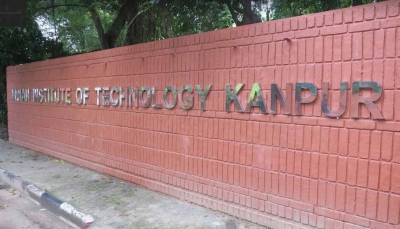IIT Kanpur & NATRAX join forces to tackle vehicle emissions
The MoU was signed by Dr Manish Jaiswal, Director of NATRAX and Prof Tarun Gupta, Dean, Research and Development, IIT Kanpur on Monday.
A team of researchers from the Indian Institute of Technology Kanpur has proposed a universal mechanism for turbulent relaxation, which can be applied to a wide range of fluids, including plasmas and complex fluids.

[File Photo]
A team of researchers from the Indian Institute of Technology Kanpur has proposed a universal mechanism for turbulent relaxation, which can be applied to a wide range of fluids, including plasmas and complex fluids.
This principle, called the principle of vanishing nonlinear transfer (PVNLT), explains how a turbulent system attains a steady, stable state of relaxation when the driving force is switched off.
The study titled ‘Universal turbulent relaxation of fluids and plasmas by the principle of vanishing nonlinear transfers’ has been published in the journal ‘Physical Review E (Letters)’.
Advertisement
The team comprises professor Supratik Banerjee, and researchers Arijit Halder and Nandita Pan from the Department of Physics, IIT Kanpur.
According to an official release, the researchers used the example of mixing milk in a cup of coffee.
“When we stir the coffee, we create eddies and turbulence that cause the milk to mix quickly. However, when we stop stirring, the system organises itself via ‘turbulent relaxation’ before it finally ceases to flow. According to PVNLT, this happens when the system gets rid of its nonlinear transfers, terminating the turbulent cascade. In this state, stability is ascertained as a scale-dependent entropy function is maximised when the correlation between different parts of the fluid tends to vanish,” said Banerjee.
The PVNLT principle has been shown to give the correct pressure-balanced relaxed states for both two and three-dimensional fluids and plasmas, as previously obtained in numerical simulations.
This means the current principle can correctly predict the way the turbulent relaxation happens in reality. This technique is fundamental and can easily be applied to complex fluids, including compressible fluids, plasmas, binary fluids etc.
“Through the principle of vanishing nonlinear transfer, we have been able to uncover a universal mechanism for understanding how turbulent systems reach a relaxed and stable state. Our research has important implications not only for the study of fluids, but also for plasmas and other complex fluids. We are excited about the potential for future applications of this principle in a wide range of fields,” added Banerjee.
This research has important implications for our understanding of cosmological plasmas. Cosmological plasmas are plasmas that exist in outer space, such as in stellar envelopes, gaseous nebulae, and interstellar space. Plasmas are a state of matter that consists of charged particles, such as ions and electrons that interact with electromagnetic fields. These plasmas are often dilute, meaning they are not very dense, but they are still important because they play a crucial role in shaping the universe.
One of the interesting features of these cosmological plasmas is that they often exhibit regular patterns, such as “force-free” magnetic fields with a clear alignment between the magnetic field lines and the current.
This alignment, popularly called a Beltrami-Taylor alignment, is important because it helps to explain the behaviour of these plasmas in outer space. For example, it can explain why some regions of space appear brighter than others in certain wavelengths of light.
The PVNLT principle provides a unified framework for understanding how turbulent systems reach a stable, relaxed state, from a cup of coffee to the cosmological plasmas. The research has the potential to open up new avenues of study and discovery in both laboratory and astrophysical plasmas.
Advertisement